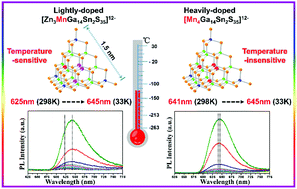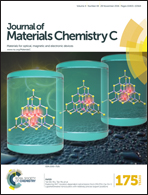Exploring Mn2+-location-dependent red emission from (Mn/Zn)–Ga–Sn–S supertetrahedral nanoclusters with relatively precise dopant positions†
Abstract
Mn2+-Doped semiconductor nanocrystals or quantum dots have been extensively studied as potential yellow/orange/red phosphors due to the stable Mn2+-related emission tuned by its tetrahedral coordination environment in host lattices. However, it is still very difficult to objectively explore the location–performance relationship in conventional Mn2+-doped nanomaterials since the precise location information on Mn2+ dopants is generally unavailable due to their random distribution in host lattices. Herein, we purposely selected a specific supertetrahedral-nanocluster-based molecular crystal (OCF-40-ZnGaSnS, composed of isolated supertetrahedral T4-ZnGaSnS nanoclusters (NCs) with the formula [Zn4Ga14Sn2S35]12−) as a host lattice, and effectively controlled the relatively precise position of Mn2+ dopants in host lattices of T4-ZnGaSnS NCs by in situ substitution of Zn2+ sites by Mn2+ ions, and investigated the Mn2+-location-dependent red emission properties. The current study clearly indicates that a long-lifetime (∼170 μs) red emission centred at 625 nm at room temperature for lightly-doped [Zn3MnGa14Sn2S35]12− NCs with one Mn2+ dopant in its surface centre is very sensitive to temperature and dramatically red-shifts to 645 nm at 33 K upon the excitation of 474 nm. However, heavily-doped OCF-40-MnGaSnS (composed of T4-MnGaSnS NCs with the formula [Mn4Ga14Sn2S35]12−, in which four Mn2+ dopants are accurately located at its core in the form of Mn4S) gives the temperature-insensitive red emission with a longer wavelength (641 nm) and a shorter lifetime (42 μs) at room temperature. This phenomenon is pretty uncommon compared to other heavily Mn2+-doped semiconductors. Such differences in their PL properties are ascribed to Mn2+-location-induced lattice strain to different degrees in two Mn2+-doped supertetrahedral NCs. In addition, the Mn2+-related red emission of both samples can be predominantly induced by the direct excitation of Mn2+ ions and secondarily by indirect excitation through exciton energy transfer from host lattices to Mn2+ dopants. Consistently, the DFT calculations suggest that the emission of NCs originated from the transition from the low spin excited state of Mn2+ (4T1) to its high spin ground state (6A1). The calculation results also revealed that the emission wavelength of lightly-doped [Zn3MnGa14Sn2S35]12− NCs is not obviously affected by the temperature-induced thermal effect, but by temperature-induced structural contraction, while that of heavily-doped [Mn4Ga14Sn2S35]12− NCs is affected by both effects. The total temperature cooling effect on the emission of [Zn3MnGa14Sn2S35]12− NCs is the red-shift, while that on the emission of [Mn4Ga14Sn2S35]12− NCs is negligible, which is akin to the experimental results. This research opens up a new perspective and provides a feasible method to explore the location–performance relationship of other Mn2+-doped NCs.

- This article is part of the themed collection: 2016 Journal of Materials Chemistry C Hot Papers

 Please wait while we load your content...
Please wait while we load your content...